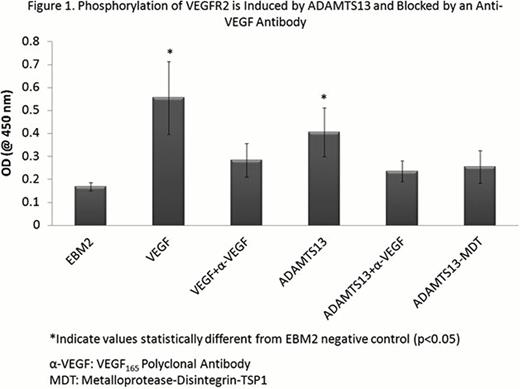Abstract
Abstract 2182
The primary role of ADAMTS13 (A Disintegrin And Metalloproteinase with ThromboSpondin type 1 motifs, 13) is to cleave unusually large von Willebrand factor (ULVWF) multimers under shear stress. Recently, we reported that ADAMTS13 may be a potent mitogen and chemoattractant, and it modulates angiogenesis in vitro (Microvas Res. 2012, 84, 109–115). However, the structural components and mechanism of ADAMTS13 modulating angiogenesis are not understood. Herein, we report the effect of ADAMTS13 variants on cell proliferation, migration, and, tube formation of human umbilical vein endothelial cells (HUVEC). In addition, we determined the signaling pathways by which ADAMTS13 promotes angiogenesis.
ADAMTS13 fragments containing TSP1 repeat (i.e. MDT, MDTCS, TSP1 2–8, TSP1 5–8 plus CUB, and TSP1 2–8 plus CUB) were used in this study. In the proliferation model, TSP1 2–8 at the concentration of 34.6 ng/mL (651 pM) increased endothelial cell proliferation by 267 %. In the chemotaxis assay, TSP1 2–8 at the concentration of 27.7 ng/mL (521 pM) increased endothelial cell migration across a gelatinized polycarbonate membrane by 71 %. Similarly, TSP1 2–8 at the concentration of 55.4 ng/mL (1.0 nM) induced endothelial cell tube formation in Matrigel by 45 %. In all three models, the TSP1 2–8 induced angiogenic responses with similar efficacy to full-length ADAMTS13. MDT and MDTCS fragments did not affect proliferation, migration, or tube formation significantly, as compared to the negative control.
To determine the mechanism by which ADAMTS13 induces angiogenesis, we incubated endothelial cells with ADAMTS13 at the concentration of 147 ng/mL (1.0 nM). We showed that ADAMTS13 increased the phosphorylation of VEGFR2, Akt, and, P44/42 MAPK, which may trigger downstream activation to promote cell proliferation and migration. Addition of anti-VEGF antibody in the culture system significantly blocked the ADAMTS13-induced effect, indicating that ADAMTS13 plays a role in promoting angiogenesis by inducing VEGF secretion from endothelial cells (Fig 1).
The biological role of ADAMTS13 in angiogenesis was further demonstrated in a chick embryo model. Collagen onplants supplemented with EBM-2 (as negative control), 40 ng/mL VEGF165 (2.1 nM) (as positive control), and 306 ng/mL ADAMTS13 (2.2 nM) were placed on the chorioallantoic membrane of day 8 fertilized white leghorn chicken embryos. Localized and sustained release of VEGF and ADAMTS13 over a course of 72 hours resulted in 8-fold increase in capillary migration into the collagen onplants. Together, our findings suggest that the TSP1 repeats of ADAMTS13 metalloprotease promote angiogenesis by inducing VEGF secretion and VEGFR2 phosphorylation.
No relevant conflicts of interest to declare.
Author notes
Asterisk with author names denotes non-ASH members.


This feature is available to Subscribers Only
Sign In or Create an Account Close Modal